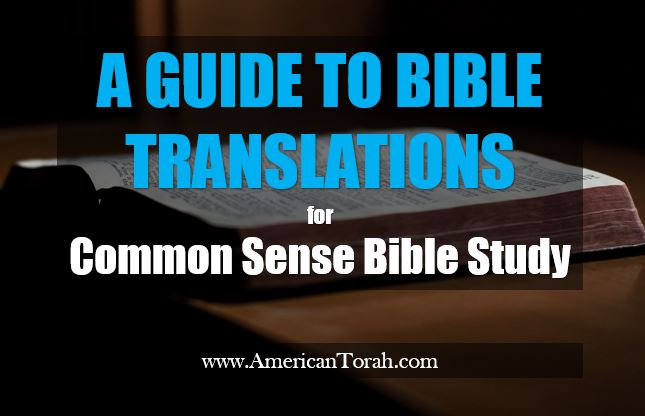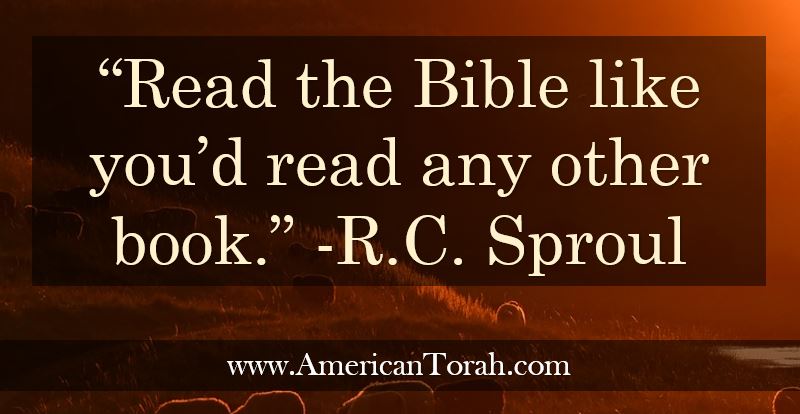
There are a lot of Bible translations out there, probably more in English than any other language. In some ways it’s embarrassing, like the thousands of Christian denominations. Why can’t everyone just read the same translation? There are some surprisingly good reasons for the many English Bibles and some disappointing ones too.
I’m going to get a little more technical in this installment, but it’s important information, so bear with me.
In part, the variety of translations are a reflection of the variety of source texts. Before the invention of the printing press, every Bible was copied by hand from an older copy. Letter shapes and vocabulary changed over time, writing faded, manuscripts were lost, and some were even deliberately changed. Some amount of error and variation was inevitable.
Today, there are thousands of ancient manuscripts that can be used to translate the Bible from the original Hebrew and Greek, but they almost all have minor variations in the text. A number of factors will influence which original a translator uses for any particular passage: readability, historical and linguistic analysis, contextual clues, and theological bias, for example.
Some translations include additional passages or even entire books. For example, Catholic Bibles include the Macabbees, Esdras, and other books that Protestant Bibles do not. Some ancient manuscripts contain passages that are missing from others, and there is always debate about whether the passage was added to one manuscript or removed from another.
This is especially true for the Gospels. For example, Matthew 17:21 is present in the Tyndale Bible (1500s), Rheims New Testament (1582 and later), and the King James Version (1611 and later editions) which are based on the Hebrew, Greek, and Latin texts available in the 16th century, but is missing from the New International Version (1973), the Holman Christian Standard (2004), and the English Standard Version (2001) which are based on older Hebrew and Greek manuscripts that were only discovered within the last century.
There are two important points to consider about the use of older source manuscripts for translating the Bible:
- Older doesn’t necessarily mean better. There were false cults and poor copies two thousand years ago, just like today. Translators need to be very careful to be aware of all the possible factors involved in selecting source texts, not just the age of the manuscript.
- The oldest manuscripts we now have of any Biblical texts date to about the 2nd century BC and they differ very little from manuscripts that were created a thousand years later. The differences that exist are almost entirely due to individual letters or spelling variations. There are exceedingly few differences that have any impact on the theological meaning of the text. This is one of the most remarkable characteristics of biblical manuscripts and, by itself, makes the Bible unlike almost any other religious text in the world.
Some English translations have been based on Latin or Greek texts that were themselves translations from Greek or Hebrew. For example, the Wycliffe and Coverdale Bibles were both based on the Latin Vulgate and the Brenton English Septuagint is based on a Greek translation of the Hebrew Old Testament. These kinds of translations can provide an interesting historical perspective on how Greek and Latin speakers might have understood the Scriptures in the early centuries of the Christian church, but they’re more likely to obscure the original meaning of the Bible than to illuminate it.
Another reason for making new translations is the evolving nature of English. The King James Version is barely readable for most English speakers today, and the meaning of enough words have changed over that time that some passages have completely changed meaning. For example, in modern English the word “replenish” means to restore something that has been depleted, like refilling a water glass, but that’s not what it meant when the KJV translators rendered Genesis 1:28 to say “replenish the earth”. Back in the 17th century, it just meant to fill it up. It’s the difference between refilling a glass and filling it the first time. It helps to have a Bible written in the same language we use every day, which only makes sense, since much of it was originally written using the same vocabulary and grammar that ordinary people used at home and in the market.
Unfortunately, such practical considerations aren’t the only reason to retranslate the Bible. Some translations were created because someone or a group of people didn’t agree with an existing translation. That’s not entirely unreasonable, but others have been created specifically to promote a theological agenda that might be foreign to the original meaning. The translators often believe they are correcting a misunderstanding, but in reality are introducing one or more.
Complicating the matter further are the different translation styles. Two linguists might agree on what a particular Greek phrase means, while still disagreeing on how it should be translated into English. Should it be translated literally, word-for-word, or should it be translated more loosely.
Take the phrase, “kill the goose that lays the golden egg,” for example. If you had to translate that from English into a different language for a people who had no knowledge of Aesop’s fables, you would have to decide whether to translate it literally and hope your readers could understand the meaning from the context or else translate it into a similar phrase in the new language.
These two styles of translation are called formal equivalence (word-for-word) and dynamic equivalence (sense-for-sense).
Formal equivalence will give a more accurate rending of the original, while dynamic equivalence will necessarily include more of the translator’s own biases. To an extent, though, all translation is dynamic because many Hebrew and Greek words have no precise equivalent in English and they can also carry extra meaning (connotations) that are unique to a particular culture or time period. Some words carry political baggage. Word order and grammar rules are different across languages. Translation can be a complicated process and even the most literal translators have to make a lot of judgment calls about what the original author really meant.
There is a spectrum even within those two general categories of formal and dynamic. For example, the King James and the English Standard Versions are both literal, but the KJV is more literal than the ESV. Young’s Literal Translation is even more literal as you could probably guess by the title, but it still has to be somewhat dynamic in order to be comprehensible.
At the extreme end of the dynamic equivalence end of the spectrum lie Bibles that are more properly called paraphrases than translations. The Message and The Living Bible are paraphrases and probably shouldn’t even be called Bibles since they are more like commentaries. Paraphrase Bibles are usually the work of one or a few authors who want to make the Bible more accessible to introductory readers and new converts. If they were labeled as commentaries or even as story Bibles, that would be fine, but they are so far removed from the original text that they are completely unreliable for any kind of real Bible study. They make great social media quotes, but unless you are unable to read or comprehend above a third-grade level, I don’t recommend wasting any time with a paraphrase Bible.
There is yet another category of translation that defies any clean labeling. I’ll call them special purpose Bibles. These are translations made in order to highlight a one or another aspect of the texts or to assist in a particular mode of study. Some might disagree with me, but I put the Complete Jewish Bible in this category. It’s a good, dynamic translation in most respects, but some words and phrases in the New Testament have been translated into Hebrew in order to emphasize the Jewish cultural background of the authors. These passages weren’t mis-translated, just translated in a peculiar manner to further an agenda. The translator, David Stern, was very open about his purpose, and wasn’t trying to deceive anyone. It’s not wrong, just…different. When you read with the understanding that it isn’t a literal translation, the CJB can give the reader a very useful perspective.
Young’s Literal Translation and the Amplified Bible are also special purpose Bibles, but fall at the opposite end of the formal-dynamic spectrum as the CJB. The YLT is difficult to read casually, but provides useful insight into the meaning of the original text without having to look up every word in a Hebrew or Greek dictionary. The Amplified Bible fills a similar niche, and might even be more literal. However, unlike the YLT, the Amplified Bible puts alternative translations in parenthesis so that it’s like reading a Bible and a Bible dictionary at the same time. Needless to say, it too is not a Bible for casual enjoyment. Most people will not want to read it straight through.
The Voice represents another–and unique–kind of special-purpose Bible. The creators attempted to capture the unique voice of each of the Biblical authors using a variety of styles. I haven’t seen it yet, but the concept sounds intriguing if dangerously close to being just a more trendy paraphrase than others.
Here’s a list of a few of the popular translations currently available that I am comfortable recommending:
Formal Equivalence
- English Standard Version (ESV)
- King James Version (KJV)
- New American Standard Version (NASB)
- New King James Version (NKJV)
Dynamic Equivalence (less dynamic)
- Holman Christian Standard Bible (HCSB)
- New International Version (NIV)
Dynamic Equivalence (more dynamic)
- Contemporary English Version (CEV, not the CEB, which is the Common English Bible)
- New Revised Standard Version (NRSV)
- New Living Translation (NLT)
Special Purpose Bibles
- Amplified Bible
- Complete Jewish Bible (CJB)
I have included several translations, such as the NIV and CEV, above that I don’t personally use very often because a few passages that I believe to have been mistranslated annoy me too much. Your mileage may vary, of course. Remember that no translation is perfect, and some will be better than others. Even the existent Greek and Hebrew texts have variations.
If you want a little more information about today’s most popular Bible versions, check out this handy chart from A. Philip Brown II.
Some people will claim that the King James Version is the one and only true English Bible, but it is trivially easy to point out glaring–even deliberate–mistranslations in its text. (Do I hear the sound of an angry mob approaching?)
Don’t misunderstand me. The KJV is outstanding. It is one of the best English translations available, but it’s still not perfect. Fallible humans were involved in its creation and printing, and they were not inspired in the same way that the original authors were. Additionally, there are very good arguments that some older manuscripts, which were not available to the KJV translators, contain superior source texts.
The existence of multiple translations of the Bible in itself isn’t a bad thing. None of the Biblical books were written originally in English–Modern English didn’t even exist as a language until about 700 years ago!–and having access to several translations is almost like being able to ask a panel of linguists what they think the best translation is for a passage. Comparing their conclusions can give us greater perspective on what the words could and couldn’t mean.
Where there is no guidance, a people falls, but in an abundance of counselors there is safety.
(Proverbs 11:14)
I recommend that you own and use several translations. (E-Sword is a great, cheap way to accomplish that, if you don’t mind reading on a computer screen. See below for more info.) For everyday reading, choose a translation on the dynamic side of literal (like the ESV or NKJV) or on the literal side of dynamic (like the HCSB or NIV). For more serious study, use formal equivalence (literal) translations alongside a Bible dictionary and a concordance. Personally, I really like the NKJV even though I usually quote from the ESV because it’s included with e-Sword for free. (See below!)
Avoid translations that were created by a specific denomination or sect and treat any translation made by a single individual as suspect. The Jehovah’s Witnesses, the Latter Day Saints, the Roman Catholic Church, and other religious organizations have created their own “approved” translations, and while they might be fantastic, the nature of such works make them much more likely to be agenda driven or skewed by theological bias.
You should find a Bible that resonates with you and that a broad range of qualified Bible scholars consider to be accurate. Stick to that as your primary Bible, but make sure to consult other translations frequently, especially when a passage seems at all confusing. Weigh every passage against the rest of Scripture.
Remember that no verse stands alone and the Bible must be interpreted in an internally consistent manner.
P.S. My favorite Bible study tool is e-Sword, phenomenal software created by Rick Meyers to facilitate access to Bible commentaries, dictionaries, translations, and other resources. It lets you quickly switch between multiple translations and even to see them side-by-side. Inclusion of dictionaries lets you look up the meaning of Hebrew, Greek, and English words in every verse. On the computer I’m using right now, I have 16 different translations, 2 Hebrew dictionaries, 2 Greek dictionaries, several encyclopedias, and 13 commentaries. Once you have the software installed, you can use the built-in tools to download and add dozens of translations, both free and paid, in dozens of languages. I can’t recommend it highly enough. If you don’t have it, you can download e-Sword for free at http://www.e-sword.net/. Consider donating or buying some of the paid modules to support the continued growth and refinement of the software.








